Removal Procedure
Tools Required
| • | J 24402-A Glass
Sealant Remover (Cold Knife) |
| • | J 39032 Stationary
Glass Removal Tool |
| • | GM Adhesive Caulking Kit P/N 10952983 or equivalent for
the installation of the glass |
| • | GM Glass Cleaner P/N 1050427 or equivalent |
| • | Household cartridge-type caulking gun |
| • | Commercial-type utility knife used to cut around the edge of the
window |
Caution: When working with any type of glass or sheet metal with exposed or rough
edges, wear approved safety glasses and gloves in order to reduce
the chance of personal injury.
Caution: If broken glass falls into the defroster outlets, it can be blown into
the passenger compartment and cause personal injury.
- Place a protective coverings on the fenders.
- Apply masking tape to the painted surfaces around the windshield
in order to prevent paint damage.
- Remove both door sealing weatherstrips from the upper pinchweld
flange.
- Remove the windshield wiper arms. Refer to
Windshield Wiper Arm Replacement
in Wiper Arm Removal in Wipers/Washer
Systems.
- Remove the antenna, if equipped. Refer to
Fixed Antenna Mast Replacement
in Entertainment.
- Remove the air inlet grille. Refer to
Air Inlet Grille Panel Replacement
in Body Front End.
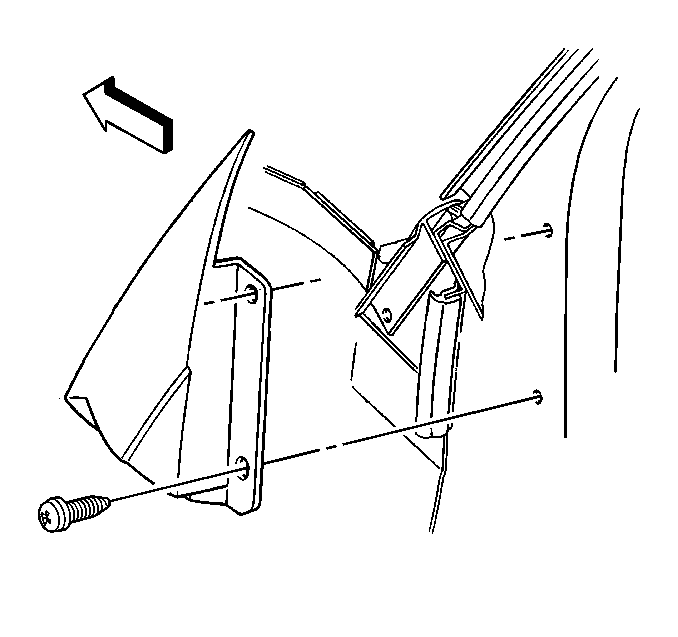
- Remove the right and left
screws that retain the windshield frame filler panel.
- Remove the frame filler panels.
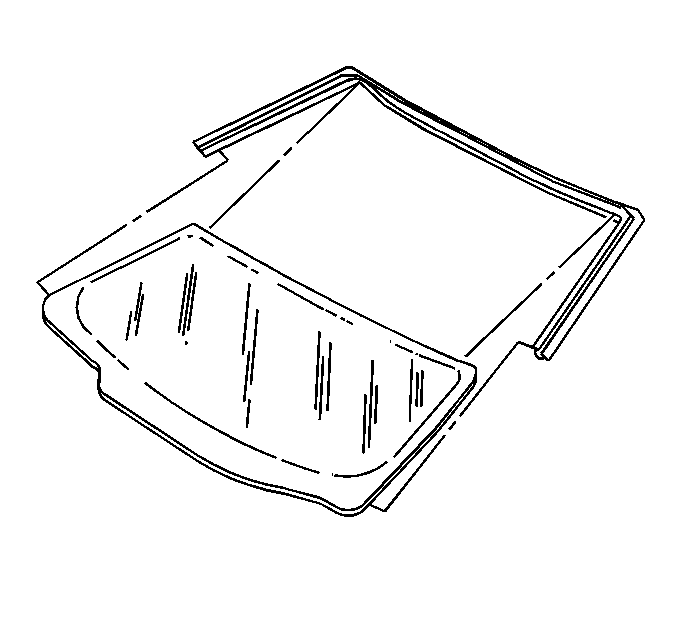
- Remove the windshield
reveal molding.
| 9.1. | Grasp the lower corner of the windshield reveal molding with your
hand and slowly pull the reveal molding away from the windshield. |
| 9.2. | If the windshield reveal molding will not release use a utility
knife to cut around the windshield to remove the windshield reveal molding. |
| 9.3. | The windshield reveal molding fills the cavity between the body
and windshield and can not be reused if stretched or damaged. |
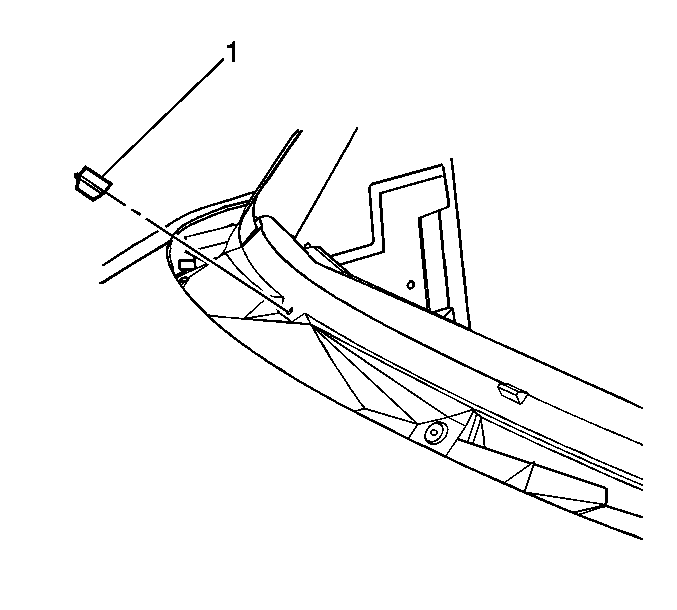
- Remove the lower windshield supports (2), if equipped.
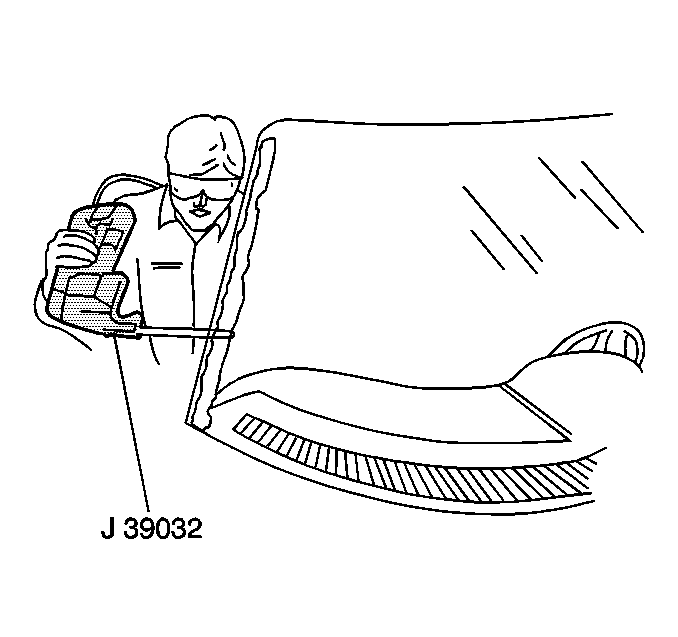
Important: When cutting out the glass apply a spray mist of soapy water around
the surface to aid in the removal.
Keep the cutting edge of the tool against the windshield, this will
allow the urethane adhesive to separated from the windshield.
- Use the J 24402-A
and J 39032
to remove
the windshield.
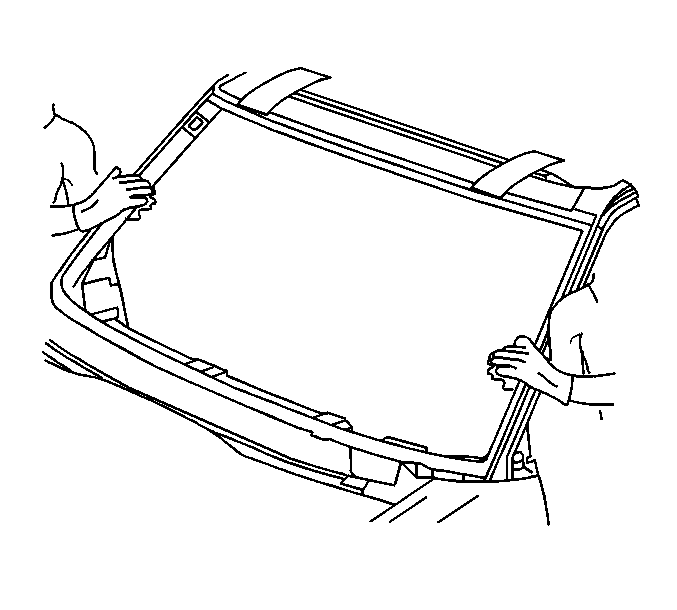
- Remove the windshield
from the vehicle with aid of an assistant.
- The following components may reveal the causes of a broken windshield:
| • | The flange of the windshield opening |
| • | The windshield reveal molding |
- Look for one of the following problems in order to help prevent
future breakage of the windshield:
| • | Hardened spot weld sealer |
| • | Any other obstruction or irregularity in the pinchweld flange. |
- Inspect the condition of the windshield opening and the adhesive
bead in order to determine which installation method should be used. Refer
to the descriptions of short or extended method for guidelines.
Important: If corrosion of the pinchweld flange is present, or if sheet metal repairs
or replacements are required, the pinchweld flange must be refinished in order
to present a clean primer only surface. If paint repairs are required,
mask the flange bonding area prior to applying the color coat in order
to provide a clean primer only surface. Materials such as BASF
DE17 ®, DuPont 2610 ® and PPG DP40 ®,
or equivalent product are approved for this application.
- After repairing the opening as indicated, perform the following steps:
| 16.1. | Shake the pinchweld primer (#3 black) well. |
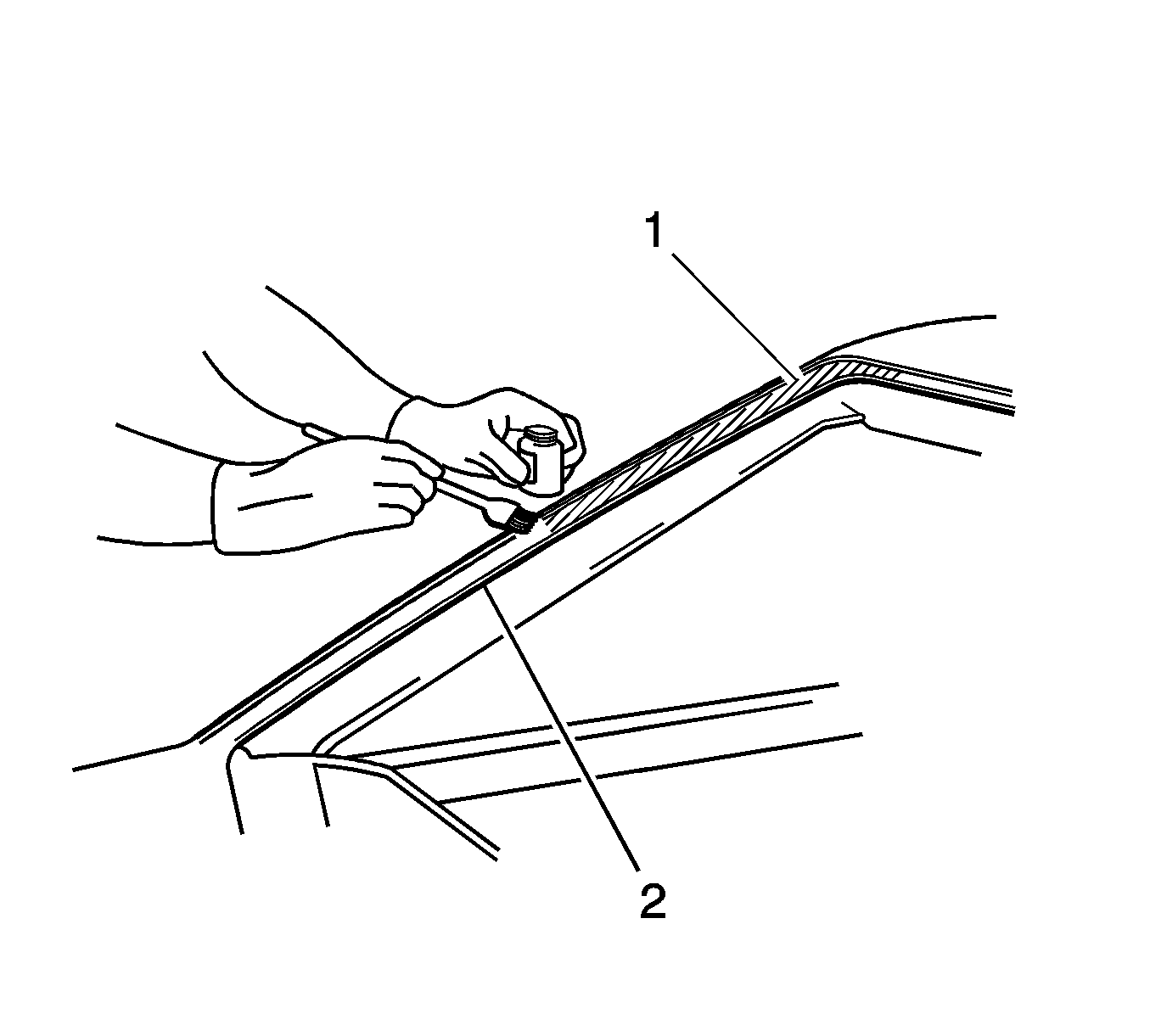
| 16.2. | Use a new dauber to apply
the primer (1) to the primed surface of the flange in the bonding area. |
| 16.3. | Allow the primer to dry for approximately 10 minutes. |
Installation Procedure

- Install the lower (2) windshield supports.

- With the aid of an assistant,
dry fit the windshield in the opening in order to determine the correct way
to position the windshield in the opening.

- Use masking tape (1) in
order to mark the location of the windshield (2) in the opening.
- Slit the masking tape at the top edge of the windshield.
- Remove the windshield from the opening.
- Place the windshield inside up on a clean, protected surface.
- If the original window is being reused, remove all but a thin
film of the existing urethane adhesive from the window surface using a utility
knife or equivalent.
- Clean the inside surface of the windshield with GM Glass Cleaner
P/N 1050427 or equivalent.
- If an extended method of installation is being performed:
| 9.1. | Remove all but approximately 2 mm (3/64 in.) of
the existing bead of urethane adhesive from the pinchweld flange. |
| 9.2. | It is not necessary to remove all traces of adhesive, but there
should not be any mounds or loose pieces left. |
| 9.3. | Shake the pinchweld primer (#3 black) well. |
| 9.4. | Use a new dauber to apply the primer to any exposed painted surfaces
(or scratches in the metal) of the flange in the bonding area. |
| 9.5. | Allow the primer to dry for approximately 10 minutes. |
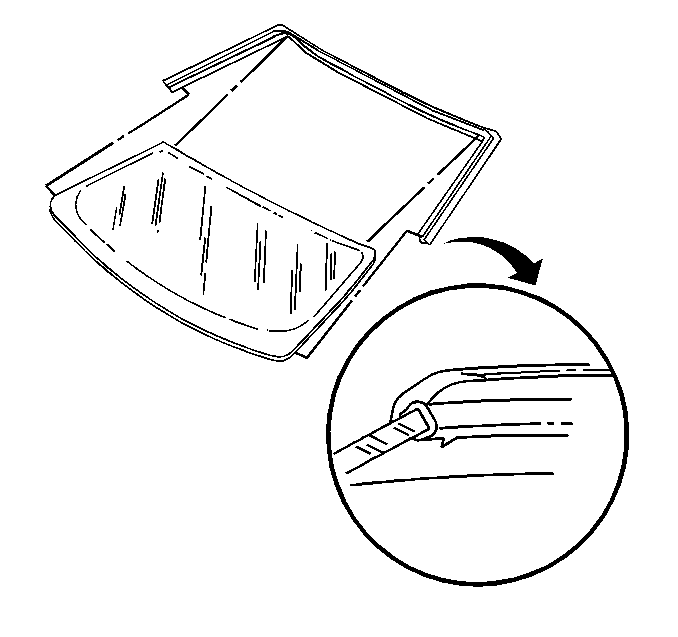
- For non encapsulated
glass, install the windshield reveal molding to the edge of the windshield.
If the original reveal molding is damaged it must be replaced.
- Install a new acoustic strip if needed.
Important: Use the following procedure:
- Use care when applying the windshield prep (#1 clear) in order to prevent
the windshield prep from running into the vision area of the windshield.
This primer dries almost instantly and may stain the viewing area of
the windshield.
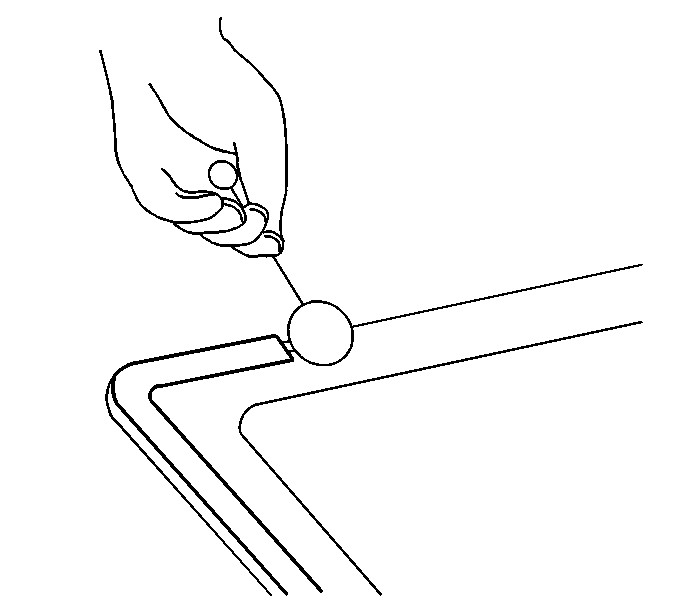
- If installing a new non
encapsulated windshield:
| 13.1. | Use a new dauber, in order to apply the windshield prep (#1 clear)
to the area approximately 10 mm to 16 mm (3/8 in 5/8 in) around the
entire perimeter of the glass inner surface (reference the illustration
of the primer/bonding areas). |
| 13.2. | Apply the windshield prep (#1 clear) to any exposed edges of the
window. |
| 13.3. | Wipe the primed area immediately with a lint free cloth. |
- If install an new encapsulated window:
Use a new dauber, in order to apply the windshield prep (#4 clear)
to the area approximately 10 mm to 16 mm (3/8 in 5/8 in) around the
entire perimeter of the glass inner surface (reference the illustration of
the primer/bonding areas).

- Shake the windshield primer
(#2 black) well.
| 15.1. | Use a new dauber, to apply the windshield primer (#2 black) to
the same areas that the windshield prep (#1 clear) was applied. |
| 15.2. | Allow the primer to dry for approximately 6 minutes. |
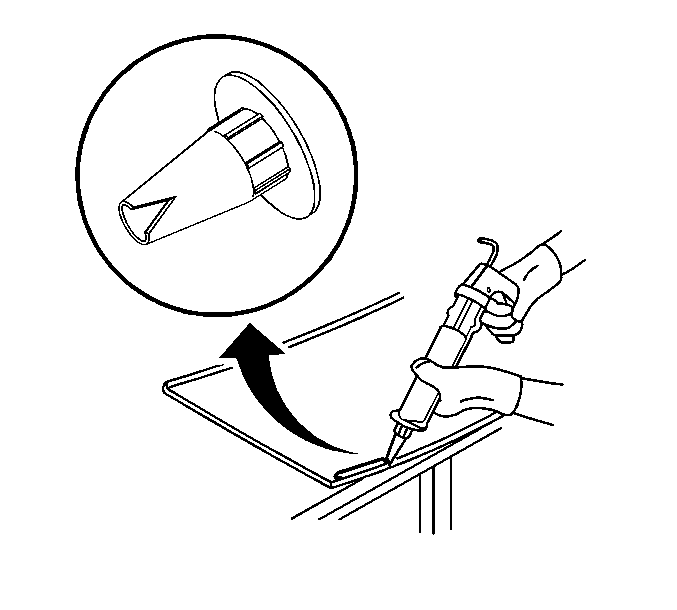
- Cut the tip of the applicator
nozzle as follows:
| 16.1. | If short method installation is being used, cut the tip to provide
an adhesive bead of approximately 6.0 mm (1/4 in). |
| 16.2. | If extended installation method is being used, cut the tip to
provide an adhesive bead of approximately 12.7 mm (1/2 in) wide and
12.7 mm (1/2 in) high. |
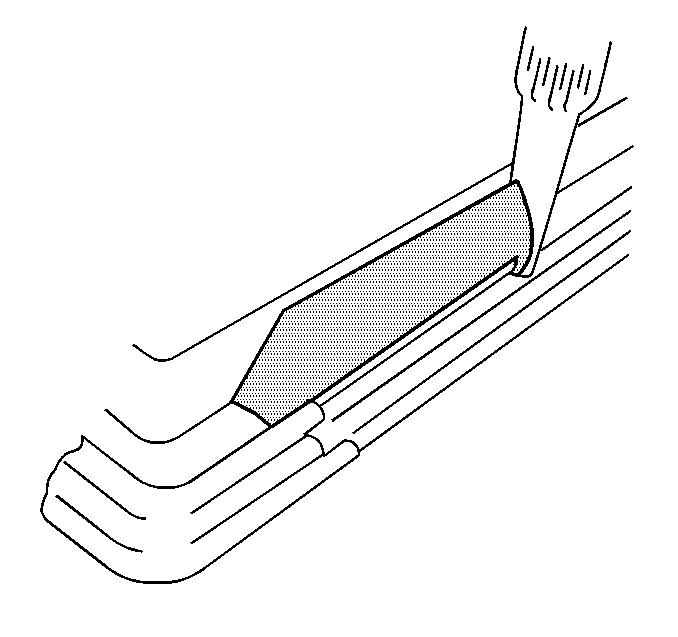
- Use a cartridge type caulking
gun, to apply a smooth continuous bead of urethane adhesive.
- When using the short installation method, apply the urethane adhesive
to the existing bead of urethane adhesive on the body.
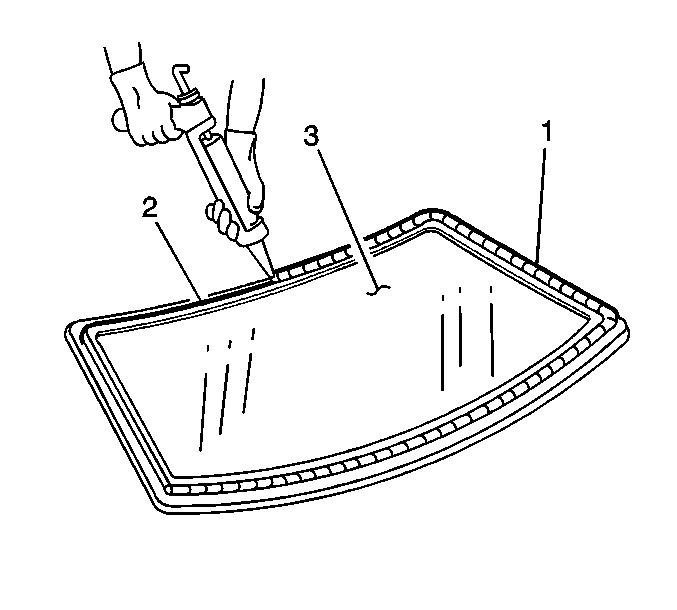
- When using the extended
installation method, use the edge of the windshield or the inside edge of
the reveal molding as a guide for the nozzle in order to apply the (2)
urethane adhesive to the inner surface of the (3) windshield.

- Use rubber suction cups,
and with the aid of a assistant, install the windshield into the opening.
- Place the windshield on the lower supports if equipped.

- Align the tape on the
windshield and the body.
- Press the windshield firmly into place.
- Tape the windshield to body in order to minimize movement.
| 24.1. | Remove any excess urethane adhesive that may have squeezed out
from the body. |
| 24.2. | Use a soft spray of water in order to water test the windshield
immediately. |
| 24.3. | Warm water is preferred in order to accelerate the cure of urethane
adhesive. |
| 24.4. | Do not direct a hard stream of high pressure water at fresh urethane
adhesive. |
Important: Inspect the windshield for leaks:
- If any leaks are found, use a plastic paddle in order to apply extra
urethane at the leak point.
- Retest windshield for leaks.
- Use the following procedure in order to properly cure the urethane
adhesive.
| • | Allow the vehicle to remain at room temperature of 22°C (
72°F) at 30 percent or less relative humidity. |
| • | Allow a minimum of 6 hours for the moisture curing urethane adhesive. |
| • | Allow a minimum of 1 to 1 1/2 hours for the chemical
curing urethane adhesive. |
| • | Partially lower a door window to prevent pressure build ups when
closing doors prior to urethane adhesive curing. |
| • | Do not drive the vehicle until the urethane adhesive is fully
cured. |
| • | Do not use compressed air in order to dry the urethane adhesive. |
- Install the remaining windshield reveal molding to the windshield.
Notice: Use the correct fastener in the correct location. Replacement fasteners
must be the correct part number for that application. Fasteners requiring
replacement or fasteners requiring the use of thread locking compound or sealant
are identified in the service procedure. Do not use paints, lubricants, or
corrosion inhibitors on fasteners or fastener joint surfaces unless specified.
These coatings affect fastener torque and joint clamping force and may damage
the fastener. Use the correct tightening sequence and specifications when
installing fasteners in order to avoid damage to parts and systems.
- Install the right
and left windshield frame filler panel screws.
Tighten
Tighten the windshield frame filler panel screws to 2 N·m
(18 lb in).
- Install the air inlet grille. Refer to
Air Inlet Grille Panel Replacement
in Body Front End.
- Install the antenna, if equipped.
Fixed Antenna Mast Replacement
in Entertainment.
- Install the windshield wiper arms. Refer to
Windshield Wiper Arm Replacement
in Wiper Arm Removal in Wiper/Washer
System.
- Install both door sealing weatherstrips to the upper pinchweld
flange.
- Remove the tape from the painted surfaces.

















